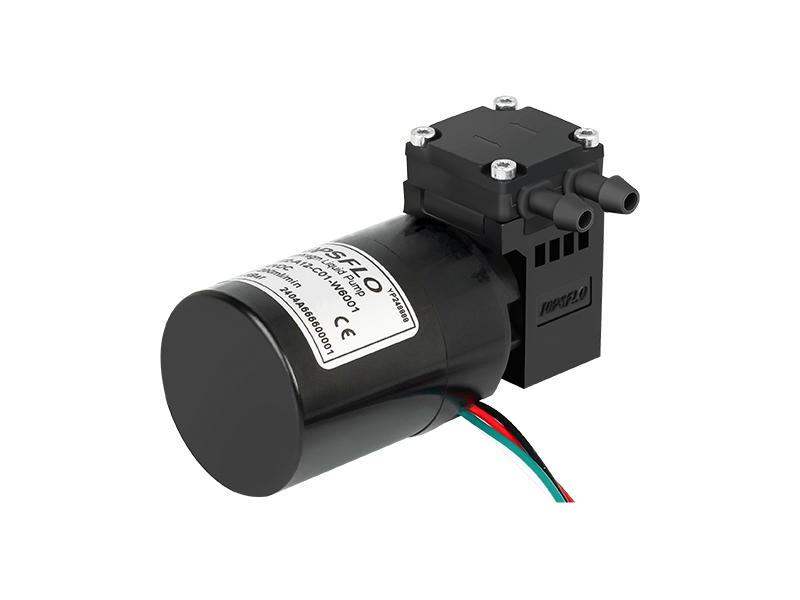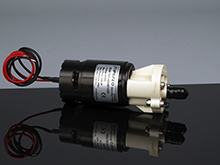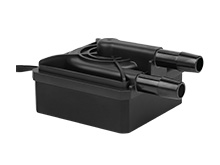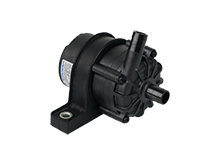Technical Information
In the pump world, accuracy is defined as the ability of a given pump to perform relative to the average population. Tighter manufacturing tolerances allow TOPSFLO Pumps to control this very well, allowing customers to set tighter control limits on their control software without fear of out-of-box calibration problems.
Precision is a pumps ability to repeat itself at a given performance point. This term applies primarily to piston pumps because they are typically used in high-precision dispense applications. The limits are shown on the product datasheets.
♦ Cavitation
Cavitation is a common problem in pumps, caused when local fluid pressures drop below the fluid’s vapour pressure. In general, pump cavitation occurs when the inlet pressures are low. For example, if there is a blocked filter on the inlet, the pump tries to pull fluid, lowering the pressure to overcome the restriction. If the pressure continues to drop (i.e., form a vacuum) the fluid boils and forms vapour bubbles that collapse, damaging the surfaces.
Symptoms of cavitation include high noise, vibration, and unstable motor speed. The noise and vibration come from the collapsing bubbles and the motor speed becomes unstable due to the uneven torque loading. Confirmation of the problem is checked by measuring the absolute pressure at the pump inlet.
Fortunately cavitation is preventable. Correct pump sizing is critical, as is design of the inlet/outlet tubing and fittings. Coarse filters are acceptable on the inlet, but fine filters should be avoided because they can plug quickly and form restrictions. Avoid small diameter fittings and long lengths of small I.D. tubing. In general, size components so that the pump can “breathe” easily and remember to increase tube and fitting I.D. for higher viscosity fluids.
The piston pumps inlet stroke of TOPSFLO Pumps occurs over only 90 degrees of rotation of the piston, so the fluid momentum is accelerating and decelerating quickly. It’s important to size the inlet tubing sufficiently large to allow the full flow through. It’s good practice to oversize the tube cross-sectional area to account for this.
♦ Dead Volume
The volume of fluid contained within the pump is referred to as the “dead volume”. The dead volume of a piston pump is normally measured with the piston fully retracted. Minimising this volume helps reduce cleaning time and fluids cost. In some pumps from TOPSFLO Pumps, we’ve included a “quick rinse” feature that routes the fluid through the magnetic coupling area to further reduce cleaning time.
♦ Dry Running
The pumps of TOPSFLO Pumps are designed to run “dry” for short periods until they self-prime. However, operating a gear or piston pump “dry” for extended periods is not recommended because it generates frictional heat that can damage pumps. The limits are shown on each product datasheet.
A word of caution: starting a gear pump completely dry causes a very loud noise. We always recommend putting a small amount of fluid into the pump prior to start-up (just enough to wet the interior surfaces).
♦ Dry and Wet Lift
The moving components in a positive displacement pumps are typically machined to very small clearances. Once these clearances are filled with fluid, the viscous shear (see Viscosity section) acts to seal the surface and increase the pump’s volumetric efficiency. When the pump is first installed in a system (and presumably dry), the surfaces are not sealed and thus air in the lines can easily get through the spaces. The pumps ability to prime itself is called its “dry lift” capability, usually expressed in mmHg or meters of H2O. The smaller the clearance between moving parts, the higher the dry lift value. Once the pump surfaces are wetted, even with just a thin layer of fluid, the clearances seal better and result in its “wet lift” capability. Positive displacement pumps always have higher wet lift values, so priming the pump prior to start-up is always beneficial: it reduces start-up response time, reduces dry friction, and lengthens pump life.
♦ Filtration
Filtering the fluid before it enters the pump is always recommended, although filters must be chosen and maintained carefully to prevent cavitation. TOPSFLO Pumps recommends a maximum filter size of 40 micrometres for gear pumps and 2 micrometres for piston pumps. The pumps will pass particles larger than this, but with increasing particle size becomes the potential to damage the pump. Never pump fluids with ferrous particles (iron, steel) through magnetically coupled pumps because the particles can stick to the magnet.
Diener developed a gear pump product line specifically designed to pump fluids with suspended particulates, especially pigmented inks and paints. The gears in these pumps are specifically hardened for this purpose but require engineering review depending on the fluid type and pigment loading. Please consult our factory for application assistance.
♦ Internal Pressure Relief Valve
Some gear pumps of TOPSFLO Pumps are fitted with adjustable internal relief valves. These serve two purposes: (1) to prevent over-pressurisation and (2) to prevent magnet decoupling. The valve is adjustable via an external screw adjustment. Pumps are provided with the valve completely closed so the customer can fine-tune its position during final installation. Caution: do not over-tighten the adjustment screw as it may damage the internal components.
♦ Life Expectancy
The life expectancy of a pump will depend on the operating conditions. These include such things as fluid type, temperature, differential pressure, contaminants, and motor speed. Careful selection of the wetted components will help minimize wear without compromising performance.
The Piston pump series of TOPSFLO Pumps are constructed of ceramic and typically last for the life of the equipment, depending on the accuracy requirement. Piston pump life is generally measured in number of cycles (strokes).
Gear pump life is more likely measured in hours, since they are typically used in continuous operation. Designing the bearings so that they stay within the pressure-velocity limits of the polymers is the key to longevity. The new Silencer series by TOPSFLO Pumps operated for 30,000 hours pumping distilled water with no drop in performance. This represents a continuous life expectancy of 3-1/2 years.
♦ Magnetically Coupled Pumps
The gear pumps of TOPSFLO Pumps are magnetically coupled to avoid shaft seals. A metallic cup separates the inner and outer magnets, eliminating the need for shaft seals. Magnetic couplings can be split into two categories: inner/outer magnet rings and stator/rotor configurations.
The inner/outer ring configuration is the most common kind of coupling. Both annular magnetic rings are magnetised radially with an equal number of poles. The rings can be made of magnetic ferrites or rare-earth materials. The ferrites are generally less expensive but larger than their rare-earth counterparts. The advantage of rare-earth magnets is the ability to miniaturise the coupling size without a loss of torque.
Ferrite magnet strength weakens with increasing temperature at a rate of approximately 0.2% per degree Celsius. Rare earth magnet strength falls off at about twice this rate. This means a lower decouple point at higher temperatures and a higher decouple points at very low temperatures.
The maximum torque a coupling can sustain is a function of the magnet material, the temperature, and the dynamic loading. When the pump load exceeds the maximum torque, the magnets “decouple”, which means the outer magnet spins at the full speed and the inner magnet stops. The magnets cannot “re-couple” unless the motor is stopped, the pump load reduced, and the unit is restarted. Running a pump in the decoupled condition does not hurt the magnets, but it will slowly generate eddy-current heating in the magnet cup, which reduces the coupling strength until normal operation is resumed.
The second coupling type (stator/rotor configuration) is the most cost effective magnetic coupling. It uses a magnet cup to isolate the fluid, but the outer ring is replaced with a motor stator and the inner magnet ring becomes the motor rotor. The advantage of this design is its simplicity and compactness. Torque limits can be controlled via current-limiting (electronically), eliminating decoupling.
♦ Pump Mounting Suggestions
All products of TOPSFLO Pumps can be operated in any position, although there are general guidelines to be aware of that will minimise potential hydraulic and/or hazard problems.
Gear Pumps:
The gear pumps can mounted in any plane, although positioning it so that the outlet is straight up will reduce priming time.
Avoid mounting pump with the motor below the pump because although the pump is magnetically coupled and thus “leak proof”, fittings and/or tubing going into the pump may break and flow down into the motor.
Piston Pumps:
To eliminate trapped air, the preferred orientation is with the outlet of the pump facing straight up. Because piston pumps have a shaft seal, the pump should be mounted so that the motor axis is always at or above the axis of the piston.
♦ Pump Ports / Fittings
Gear pumps are usually configured with inlet/outlet ports in the same plane.
We define the locations as follows: side, deck, face ports.
Pumps with moulded ports and/or Diener-supplied port fittings are sized for optimum pump performance. We recommend that customer-supplied fittings be carefully sized and applied to avoid the following problems:
1. The inside diameter of the fittings should be large enough to minimise the chance of cavitation.
2. Tapered pipe thread fittings should be used with a liquid thread sealant or Teflon tape.
3. Parallel pipe fittings should include a shoulder O-ring or thread sealant.
4. Plastic tube fittings swell with increasing temperature, so select them carefully if operating across a wide temperature range.
♦ Temperature Effects
The fluid and ambient temperature ranges are shown on each product datasheet . These limits can be customised by TOPSFLO Pumps engineering team for elevated temperature or cryogenic applications.
The gears in most of our pumps are usually constructed of engineering thermoplastics with a fibre reinforcement to increase strength and control thermal expansion. The clearances in these pumps are kept relatively small to improve volumetric efficiency, which means the specific flow may increase as the gears expand. This is not a problem unless the temperature increases so much that the gears bind in the cavity. Staying within the specified temperature ranges will ensure reliable operation.
The ceramics used in the piston pumps are thermally stable so the displacement will remain constant across the datasheet temperature range.
♦ Viscosity
Viscosity is a fluid’s resistance to shear stresses and is sometimes referred to as the “thickness” of a fluid. Viscosity is typically measured as Dynamic or Kinematic. Dynamic viscosity is a fluids shear resistance to itself (usually expressed as centipoise, where 1 cP = 1 mPa-s = 0.001 Pa-s) and Kinematic is the ratio of the Dynamic viscosity to its density and typically has the units of Stokes (m2/second).
We often compare a fluid’s viscosity relative to water. A fluid thicker than water is more viscous, while thinner fluids are less viscous.
Pumping higher viscosity fluids requires slowing the pump speed and increasing the size of interior pump openings and tube diameters.












